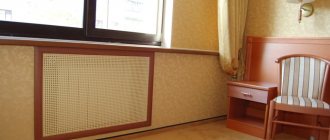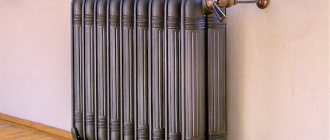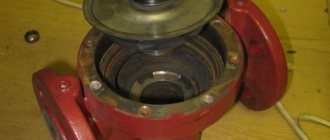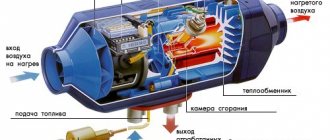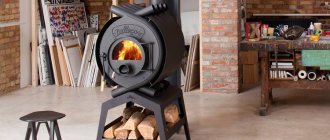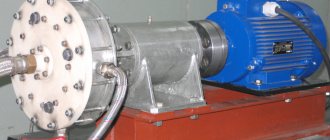The construction of greenhouses and sheds, the laying of utilities - all this requires a bent metal profile. But buying pipes bent to order is expensive, and purchasing a ready-made pipe bender is also not a cheap pleasure. So modern craftsmen use devices and self-made mechanisms to create metal arcs of the required radius.
In this article we will consider the following questions:
- Types of homemade pipe benders and their features.
- The design of the simplest device for bending square pipes.
- Design of a three-roll machine for bending round and square pipes.
- Technology for bending pipes using a three-roll homemade pipe bender.
Types of pipe bending devices and mechanisms
Nowadays, you can find examples of pipe bending equipment that have different designs: from relatively simple devices for manual bending to homemade machines with manual or electric drive.
According to their purpose, pipe benders are divided into two types.
The first type is angular (they allow you to give the desired radius to a certain area of the workpiece).
The second type is three-roll pipe benders - machines and devices that allow you to form a given bending radius along the entire length of the workpiece.
Depending on the method of adjusting the radius, pipe benders are mechanical.
And hydraulic.
The support shaft drive can be either manual or electric.
Device
Pipe benders come in different drive types and designs, but they have one thing in common: the use of mechanical force that deforms the pipe in the required way. Structurally, such units include the following elements:
- Steel frame on which the bending mechanism is mounted;
- Durable metal strips, fixing rollers;
- The rollers themselves, which serve to fix the workpiece;
- Clamping mechanism with a punch of the required curvature and radius;
- Supports that support the system above the floor for ease of operation.
This description is just an example, since depending on the type of drive and the source of force that bends the pipe, pipe benders have significant differences in design.
A simple device for bending metal pipes
The design of a homemade pipe bender depends on the volume and complexity of the work that is planned to be performed with its help. If the device is needed for one-time use (for example, for building a home greenhouse), then there is no need to create a complex three-roll mechanism with hydraulic adjustment of the bend radius.
belor44 FORUMHOUSE user
We urgently need to install a greenhouse. I want an arched one, but neither one based on metals nor my friends have a pipe bender. Build a pipe bender on shafts and rollers? There is neither time nor need for this. I think that a device for manual bending is suitable for one construction.
Yes, indeed, the simpler the pipe bender, the less hassle there is in its manufacture. The main thing is to correctly determine the dimensions of the device, which will directly depend on the bending radius.
We present to your attention a device made by the user moning. It is designed to work exclusively with thin-walled pipes, because bending pipes by hand is hard physical labor.
Moning User FORUMHOUSE
I made this thing for a 30*30 square pipe. The radius that was obtained was approximately 1 meter. You can weld something like spacers or legs on the sides of the device so that it doesn’t throw from side to side when you press on the pipe. Regarding the jumpers at the bottom of the pipe bender: first, the pipe is placed under the top jumper (for the initial bend), then the pipe is placed under the next jumper (for further advancement).
Consistent bending is necessary so that if there is a sharp bend, the pipe does not break.
Calculating the dimensions of the device is very simple: to do this, it is enough to know the bending radius that needs to be obtained on the finished part. The strip (40 mm wide), which serves as a mandrel for the workpiece to be bent, initially has a curvature that provides a given bending radius (R).
Taking into account the presence of elastic deformations, the radius of the mandrel should be slightly smaller than the required bending radius of the workpiece.
According to the author of the invention, the radius of the workpiece is, although not significantly, larger than the radius of the mandrel itself.
Knowing how to use welding, a grinder and auxiliary tools, this device can be made in less than 1 day.
Each metal pipe has its own elastic limit, therefore, the bending radius cannot be reduced below certain values. Permissible minimum radii can be taken from the corresponding tables.
We present an example of a table of permissible radii for round pipes.
Minimum bending radii of pipes in a cold state
| Pipe outer diameter, mm | Bend radius, min | |||
| 45 | 35 | 20 | 10 | |
| R bend, min | ||||
| 18 | 74 | 62 | 56 | 43 |
| 24 | 95 | 79 | 65 | 55 |
| 32 | 115 | 96 | 79 | 67 |
| 38 | 156 | 131 | 107 | 91 |
| 50 | 197 | 165 | 136 | 115 |
| 60 | 238 | 199 | 165 | 139 |
| 75 | 280 | 260 | 194 | 173 |
| 80 | 324 | 270 | 224 | 190 |
| 90 | 362 | 302 | 250 | 213 |
Why is it worth it
All three ways to make a simple pipe bender with your own hands are effective and accessible to anyone who has plumbing skills, knows how to work with electric welding and read technical drawings. In a small metalworking workshop or metalworking shop, building a homemade pipe bender is all the more easy - if you have specialists from different fields, you can make the tool in one day.
Why a homemade pipe bender is relevant for industrial enterprises will be understood by everyone when they see the prices for factory-made machines. When you assemble a pipe bending machine yourself, even if you have to buy all the parts on the market or in a store, it will cost several times less than when purchased. Moreover, a pipe bender made by yourself can be maximally adapted to your needs by making changes to the basic drawings, according to the specifics of its future use.
Manufacturing of electromechanical pipe bender
In the design of an electromechanical pipe bender, three main working parts can be distinguished: one pressure and two support (drive) shafts. Hence the name of the machine – three-roll rolling pipe bender.
Such a device has a rather complex design, so if you were unable to get the drawings of a homemade pipe bender, we recommend that you first draw each of its elements on paper (at least as a sketch). And we will tell you step by step what dimensions and characteristics the main components of the future product should have.
So, the main function of a pipe bender is to bend parts to a given bending radius. The bending radius depends on the distance between the support rollers (shafts) and is adjusted by the pressure roller. The distance between the support rollers is a constant value. This is what should be taken into account when starting to design a machine.
Alli58ru FORUMHOUSE user
The distance between the lower rollers depends on the minimum bending radius. When determining it, keep in mind that the smaller the distance between the rollers, the harder it is to lower the pressure roller and the harder it is to pass the workpiece between the shafts. And vice versa: the greater the distance, the easier it is to twist. For me, if memory serves, the distance is about 35-40 cm. The shafts rotate quite easily: I bent a minimum radius of about 50 cm, but less is possible.
The bend radius (arc radius) is calculated using a simple geometric formula.
Guided by it in relation to your equipment, you can quickly adjust the machine to the specified parameters.
Work specifics
The physical properties of the material largely determine the features of working with copper. Due to plasticity, the workpiece at the bend may decrease in diameter or even break. But you can deform a copper pipe manually. Methods for increasing bending strength will be described later.
The second feature of copper pipes is the need to heat them to effect deformation. Of course, it’s easy to handle thin-walled workpieces without a soldering iron or a gas torch, but it’s better to heat thicker elements (where there will be a bend) to make your work easier.
The third feature of bending copper pipes at home is the mandatory use of compensating elements. This is necessary to minimize the appearance of “corrugations” (waviness) on the inner wall of the tube. Examples would be sand, a steel spring, sometimes ice. Now let's look at the known methods of how to bend a copper tube at home.
Manufacturing of rollers
To make rollers, you should look for reliable materials that have already passed the strength test. Some use rotors from electric motors of old washing machines or kingpins from a KamAZ vehicle, others use carbon steel circles. In fact, there are many options, the main thing is not to forget that the chosen material must be strong enough. User Dva11, for example, used wheel hubs from an old sprinkler installation.
Dva11 FORUMHOUSE user
Hub diameter – 75 mm, length – 110 mm, bearings were selected according to the hub (205 fit). I had to buy 5 bearings and 1 pulley, and made the rest of the parts from scrap metal.
Smooth cylindrical shafts are a universal option. They are used to bend pipes of various sections. If the profile of the shafts is brought into line with the profile of the pipes being bent, the quality of bending will noticeably improve.
You can also use blanks designed for different profiles of bent workpieces.
Ideally, removable nozzles or ring clamps (limiters) are installed on the shafts, with the help of which the profile of the rollers is adjusted to the width of the pipe.
rusi45 FORUMHOUSE user
I made some improvements to the design of the rollers: I made attachments for the pipe on the outer shafts, where the stops are located. Tests were carried out on a 1 inch pipe. The attachments are easy to replace. To do this, I made one side of the bearings sliding. The nozzle is made of steel 65G (plus hardening). There is virtually no wear, and the file does not take hardness.
The internal radius of the roller or nozzle for a round pipe should be made with a margin: the radius of the pipe plus 1-2 mm. For example, if the pipe diameter is 24 mm, then the internal radius of the roller will be 13-14 mm. Only in this case the pipe will not jam during rolling.
This is the size we are talking about.
If a pressure roller designed for bending rectangular pipes has a slight convexity in the middle, this will help maintain the geometry of the profile being bent. The roller will press the upper wall of the pipe inward, preventing the workpiece from spreading out to the sides.
Main rules
The main causes of defects in pipe bending are incorrect (usually too small) bending radius and a short technological shank (“tail”), the distance from the end of the pipe closest to the bend to its beginning. The “tail” is needed not only for reliable fastening of the pipe, the “tail” is also an absorber for the release of technological stresses. A perfectly correct pipe bender can produce a wave or a defect (parasitic bend).
The rules for choosing the bending radius of the pipe RIZG and the length of the technological shank L are summarized in the table:
IZGIZG
- If the difference between the real and the nearest tabulated values of the pipe diameter P is more than 10%, the values of the initial calculated values are calculated by interpolation. Otherwise, we take the nearest one.
- The tabulated RIZG is reduced to the relative value rIZG, i.e. It is expressed in pipe diameters D or heights H.
- For pipes with a diameter of up to 10 mm, 1 is subtracted from rIG.
- For pipes with a diameter of 11 to 15 mm, 0.85 is subtracted from rIG.
- For pipes with a diameter of 16 to 24 mm, 0.75 is subtracted from rIG.
- For pipes with a diameter of 25 to 40 mm, 0.65 is subtracted from rIG.
- For pipes with a diameter of more than 40 mm, 0.5 is subtracted from rIG.
- Convert the relative rIZG back to the numerical (millimeter) RIZG.
- From the obtained value of RIZG, take the nearest practically convenient larger one.
Example: you need to bend 24x24x1.5 from a steel pipe, i.e. already classified as thin-walled, complex semi-arches for a flower house or hut. The structure is non-residential, light, the complex semi-arch is not a load-bearing structure (see below), i.e. "plumbing" wave and taffy are acceptable. We take data for the pipe H=25. According to the table we find rIZG = RIZG/H = 80 mm/25 mm = 3.2. Subtract the correction (for pipe H=25!): 3.2 – 0.65 = 2.55. Convert back to millimeters (again according to the table H=25!): 2.55x25 = 63.75 mm. That is, if we take a new bending radius of 65 mm instead of the “defect-free” 80, then the selection of bending devices and work will be simplified, the possibilities of artistic expression by the shape of the structure will increase, and there will be no visible and/or dangerous defects in the finished structure.
Simple - radius
A specific pipe bender is designed for a bend radius within certain limits. But to select a design prototype, you immediately need to know only its very general meaning:
- for small radii RIZG<5D (or 5H);
- for average radii 5IZG<20 D or H;
- for large radii 20D(H)IG;
Frame design
Having decided on the center distance and the design of the rollers, you can mark the blank parts for the frame. Based on the experience of FORUMHOUSE users, it should be concluded that the strongest frames are made from steel channels (at least 80 mm wide). This material is easy to get, so you can safely take note of it.
The photo shows the machine at the manufacturing stage. And here is the drawing that is taken as a basis.
Person User FORUMHOUSE
During the work, some changes were made to the original drawings.
The presented drawing is not a mandatory guide to action, but provides an objective understanding of how a rolling pipe bending machine works.
Required Tools
To assemble a pipe bender, you need at least the following tools:
- welding inverter;
- angle grinder;
- lathe (or purchase of finished parts);
- vice;
- hammer;
- metal file;
- sandpaper;
- ruler;
- drill.
But the most important thing is the pipe bender drawings. The mechanism must be manufactured strictly according to the drawing. You can take a ready-made drawing from this material or find another one and adapt it to the required dimensions.
But it is impossible to make a pipe bender without a drawing, since precise calculations are needed to ensure the operation of the mechanical parts.
Clamping mechanism
Many craftsmen make a clamp from a regular car jack (mechanical or hydraulic). The forces that it is capable of creating are quite sufficient to give the metal workpiece the desired configuration.
greysv FORUMHOUSE user
I used an old gazelle screw jack as a clamping screw. Easily bends two 20x20 tubes.
If a hydraulic jack is used, it must be rated for 2 tons or more. The main advantage of a hydraulic clamp is that it can be operated without much effort. Advantages of a screw jack: it is easier for them to set the bending radius.
Instead of a mechanical jack, homemade screw clamps are often used. They also allow you to bend workpieces exactly according to specified parameters.
moning
Why is a screw worse than a jack? Order a screw with a smaller thread pitch from a turner so that less effort is applied when rotating. This will cost an order of magnitude cheaper than a jack.
Types of methods
A pipe bender for metal-plastic pipes is a basic machine that operates on one mechanics. The machine is indispensable for pipelines, including thick-walled and metal-plastic ones. It can work with different types of metal (steel, aluminum, copper, zinc and their alloys). For greater productivity, the bend areas can be pre-red to release the metal, relieve internal stress and make it softer.
Cold method
Common in garage craftsmanship. If you don’t have a blowtorch or burner, you can use it. The disadvantage is that it requires more effort. Cold metal is harder and can crack. Therefore only suitable for raw steel and soft non-ferrous metals. Safer compared to hot rolling, since you don’t have to work with high temperatures.
Hot method
Requires a torch and blowtorch. Heating relieves stress from the metal and therefore it becomes more pliable, but this is only relevant for thin-walled pipes. Thick-walled tubes cannot be heated to more than 300 degrees in a garage.
Electric drive
It takes a lot of effort to push a workpiece through a machine using a mechanical handle. Therefore, mechanization of manual labor is a completely justified goal.
A suitable electric motor and a small mechanical gearbox will help you bend pipes “with a cup of coffee in your hands.” These devices are installed on the frame of the pipe bending machine in accordance with the prepared drawings. The drive sprocket mounted on the gearbox shaft can be connected to the support shafts with a metal chain (for example, from the timing belt of a passenger car).
Human
I had a 380V electric hoist lying around in the garage for about 15 years, and I was still thinking about where to use it. It weighs 40 kg and lifts up to 500 kg. A long time ago I bought a small hoist, which, with a weight of 8 kg, lifts the same amount. So: I disassembled it, removed everything unnecessary, after which I got an electric motor and gearbox in one bottle. This item weighs 6–7 kg.
We looked at the main elements of a pipe bending machine, which, if desired and with some ingenuity, can be made independently. At the end of the article, we’ll talk about how to use this equipment correctly so as not to spoil the workpiece.
Operating rules
In order for a homemade device to perform its functions correctly, you must adhere to a few simple operating rules:
- when using a welded pipe with a straight weld, the seam should be positioned towards the bend;
- in order to bend a pipe of larger diameter, it is recommended that at least two people work together;
- daily inspect equipment, various mandrels, and additional equipment to ensure that there are no loose nuts on bolts, cracks in welding or other visual defects on working surfaces;
- Periodically lubricate bearings, chains and other rotating and rubbing parts and mechanisms using high-quality lubricant.
Some useful tips
There are several ways to obtain bent copper pipe. Each is good in its own way, but there are points that are always important to take into account, regardless of the chosen deformation method.
- The main requirement for the user when working is accuracy and attentiveness. Sudden movements will lead to excessive deformation of the pipe walls and their complete rupture.
- Parts made of annealed copper are the easiest to bend, so heating them takes a minimum of time.
- If the bend is not made where needed, you can reheat the workpiece and bend the product back. However, no one guarantees that the shape of the tube will be the same.
- If the surface overheats, the metal may simply begin to melt. It is unacceptable. The user must carefully follow the process from start to finish.


